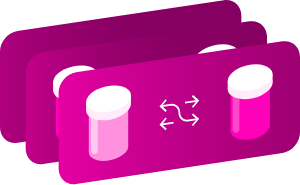Identification
- Summary
-
Talimogene laherparepvecis a genetically modified virus used to treat recurrent melanoma, or metastatic melanoma.
- Brand Names
-
Imlygic
- Generic Name
- Talimogene laherparepvec
- DrugBank Accession Number
- DB13896
- Background
-
Talimogene laherparepvec is an oncolytic treatment used in local treatment of unresectable cutaneous, subcutaneous, and nodal lesions in patients with recurrent melanoma. It is a genetically administered herpes simplex virus 1 (HSV-1) that expresses human cytokine granulocyte-macrophage colony stimulating factor (GM-CSF) with antitumor and immune-stimulating activities. It specifically replicates within tumor cells and causes lysis. It was approved by the FDA in 2015 under the market name Imlygic.
In general, talimogene laherparepvec has been modified so that it can infect and multiply inside melanoma cells4。The drug subsequently uses the melanoma cells' own machinery to multiply, eventually overwhelming the melanoma cells and killing them4。Alternatively, although talimogene laherparepvec also enters healthy cells, it is not designed to multiply inside them4。
- Type
- Biotech
- Groups
- Approved, Experimental, Investigational
- Biologic Classification
-
Protein Based Therapies
Other protein based therapies - Protein Structure
-

- Protein Chemical Formula
- Not Available
- Protein Average Weight
- Not Available
- Sequences
- Not Available
- Synonyms
-
- T-Vec
- Talimogene laherparepvec
Pharmacology
- Indication
-
This medication is a genetically modified oncolytic viral therapy indicated for the local treatment of unresectable, cutaneous, subcutaneous, and nodal lesions in patients with melanoma recurrent after initial surgeryLabel。在其他地方,EMA指出,印度的代理ated for the treatment of adults with unresectable melanoma that is regionally or distantly metastatic (Stage IIIB, IIIC, and IVM1a) with no bone, brain, lung, or other visceral diseases2。
 Reduce drug development failure ratesBuild, train, & validate machine-learning models
Reduce drug development failure ratesBuild, train, & validate machine-learning models
with evidence-based and structured datasets.Build, train, & validate predictive machine-learning models with structured datasets. - Associated Conditions
- Contraindications & Blackbox Warnings
-
 Avoid life-threatening adverse drug eventsImprove clinical decision support with information oncontraindications & blackbox warnings, population restrictions, harmful risks, & more.Avoid life-threatening adverse drug events & improve clinical decision support.
Avoid life-threatening adverse drug eventsImprove clinical decision support with information oncontraindications & blackbox warnings, population restrictions, harmful risks, & more.Avoid life-threatening adverse drug events & improve clinical decision support. - Pharmacodynamics
-
Talimogene laherparepvec has been genetically modified to replicate within tumors and to produce the immune stimulatory protein GM-CSF (granulocyte macrophage colony stimulating factor)Label。The medication causes lysis of tumors, followed by the release of tumor-derived antigens, which together with virally derived GM-CSF may promote an anti-tumor immune response in the bodyLabel。
- Mechanism of action
-
Talimogene laherparepvec is an oncolytic immunotherapy that is derived from Herpes Simplex Virus type-1 (HSV-1)3。It has been modified to replicate within tumor cells and to produce the immune response stimulatory protein, human GM-CSF (granulocyte macrophage colony stimulating factor)3。The medication causes the death of tumor cells and the release of tumor-derived antigens3。It is believed that together with GM-CSF, talimogene laherparepvec can promote a systemic anti-tumor immune response and an effector T-cell response3。Mice subjects involved in talimogene laherparepvec treatment studies that had complete regression of their primary tumors following therapy were resistant to subsequent tumor rechallenge3。
The genetic modifications to talimogene laherparepvec from HSV-1 include deletion of the ICP34.5 and ICP47 genes3。而抗病毒免疫反应保护诺玛l cells following infection by talimogene laherparepvec, tumors have been shown to be susceptible to injury and cell death from ICP34.5-deficient HSV-1 derived viruses, including talimogene laherparepvec3。Moreover, deletion of ICP47 prevents the down-regulation of antigen presentation molecules in the targeted tumor cells and increases the expression of the HSV US11 gene, thereby enhancing the talimogene laherparepvec viral replication in tumor cells and increases chances of tumor cell injury and death3。
Although the talimogene laherparepvec virus is specifically modified to infect and multiply inside melanoma cells and uses melanoma cells' own machinery to multiply, the medication is not designed to multiply inside healthy cells, which it is also capable of entering4。
Target Actions Organism AHeparan sulfate Not Available Humans ADNA polymerase catalytic subunit activatorHHV-1 ADNA polymerase catalytic subunit activatorHHV-3 - Absorption
-
Cellular uptake of talimogene laherparepvec occurs through HSV-1 receptors on both tumor and non-tumor cells following local injection into physical tumors3。After injection, the talimogene laherparepvec subsequently replicates intratumorally, where bioavailability and systemic concentration of the agent are not largely predictive of drug substance activity and therefore such data has not been evaluated to any particular degree3。
- Volume of distribution
-
Talimogene laherparepvec is a genetically modified and replication-competent HSV-1 virus3。Therefore, its pharmacokinetics and biodistribution are driven by the specific site of intralesional injection, tumor-selective replication, and release from tumor tissue3。As a result, the specific pharmacokinetics of the agent, including distribution may vary depending on particular parameters of each unique administration.
- Protein binding
-
Talimogene laherparepvec is a genetically modified and replication-competent HSV-1 virus3。Therefore, its pharmacokinetics and biodistribution are driven by the specific site of intralesional injection, tumor-selective replication, and release from tumor tissue3。As a result, the specific pharmacokinetics of the agent, including any kind of protein binding may vary depending on particular parameters of each unique administration.
- Metabolism
-
Talimogene laherparepvec is cleared through general host defense mechanisms like autophagy and adaptive immune responses3。The agent is ultimately degraded by common endogenous protein and DNA catabolic pathways3。As with other wild-type HSV-1 (herpes simplex virus type-1) infections, a latent pool of talimogene laherparepvec DNA may persist in neuronal cell bodies innervating the injection sites3。Consequently, the occurrence of latent infection with talimogene laherparepvec cannot be excluded3。
- Route of elimination
-
In an ongoing melanoma study, interim results from 30 patients show that talimogene laherparepvec DNA was detected at transient and low concentrations in blood in 90% of patients and in urine in 20% of patients in the study, which suggests that perhaps at least some portion of the drug is eliminated in the urineLabel,2,3,4。
- Half-life
-
Readily accessible data regarding the half-life of talimogene laherparepvec is not available, although talimogene laherparepvec DNA has been found in patient subjects' injected tumor through 84 daysLabeland the half-lives of antibody-based therapeutics are often times generally long, on the order of days versus hours with small molecule drugs1。
- Clearance
-
Although readily accessible data regarding the clearance of talimogene laherparepvec is not available, in an ongoing melanoma study, it was determined that the proportion of patients with detectable talimogene laherparepvec DNA in blood and urine was highest during the second cycle of therapy3。Additionally, even though talimogene laherparepvec DNA was detected in samples from injected lesions in about 90% of patients, only 14% of patients tested positive for infective virus by 50% Tissue Culture Infectious Dose (TCID50) assay, all within 8 days of treatment administration3。17% of samples from the exterior occlusive dressing tested positive for talimogene laherparepvec DNA but none tested positive for the presence of infective virus3。Moreover, only 1 sample had detectable talimogene laherparepvec DNA located on the oral mucosa - but the sample did not test positive for the presence of infective virus3。
- Adverse Effects
-
 Improve decision support & research outcomesWith structured adverse effects data, including:blackbox warnings, adverse reactions, warning & precautions, & incidence rates.Improve decision support & research outcomes with our structured adverse effects data.
Improve decision support & research outcomesWith structured adverse effects data, including:blackbox warnings, adverse reactions, warning & precautions, & incidence rates.Improve decision support & research outcomes with our structured adverse effects data. - Toxicity
-
There is no clinical experience with overdose with talimogene laherparepvecLabel,2。Doses up to 4 mL at a concentration of 10^8 PFU/mL every 2 weeks have been administered in clinical trials with no evidence of dose-limiting toxicityLabel,2。The maximum dose of talimogene laherparepvec that can be safely administered has not been determinedLabel,2。
Nevertheless, some adverse reactions that are possible from taking talimogene laherparepvec range from fatigue, chills, pyrexia, nausea, influenza-like illness, injection site pain, to even injection site complications (including cellulitis, systemic bacterial infection, and others), herpetic infection, or plasmacytoma at or near the injection siteLabel,2。
As a result, healthcare providers and caregivers must observe the necessary safety precautions when administering talimogene laherparepvec to patients as accidental exposure to the agent can lead to exposure to and transmission of talimogene laherparepvec and herpetic infection in individuals who do not need the medication or in whom the medication is not indicatedLabel,2。Moreover, in the event of a suspected overdose or inadvertent intravenous administration, the patient should be treated symptomatically, ie. with acyclovir or other anti-viral agents and supportive measures instituted as neededLabel,2。
- Pathways
- Not Available
- Pharmacogenomic Effects/ADRsBrowse all" title="" id="snp-actions-info" class="drug-info-popup" href="javascript:void(0);">
- Not Available
Interactions
- Drug InteractionsLearn More" title="" id="structured-interactions-info" class="drug-info-popup" href="javascript:void(0);">
-
This information should not be interpreted without the help of a healthcare provider. If you believe you are experiencing an interaction, contact a healthcare provider immediately. The absence of an interaction does not necessarily mean no interactions exist.
Drug Interaction Integrate drug-drug
interactions in your softwareAmbroxol The risk or severity of methemoglobinemia can be increased when Talimogene laherparepvec is combined with Ambroxol. Articaine The risk or severity of methemoglobinemia can be increased when Talimogene laherparepvec is combined with Articaine. Benzocaine The risk or severity of methemoglobinemia can be increased when Talimogene laherparepvec is combined with Benzocaine. Benzyl alcohol The risk or severity of methemoglobinemia can be increased when Talimogene laherparepvec is combined with Benzyl alcohol. Bupivacaine The risk or severity of methemoglobinemia can be increased when Talimogene laherparepvec is combined with Bupivacaine. Butacaine The risk or severity of methemoglobinemia can be increased when Talimogene laherparepvec is combined with Butacaine. Butamben The risk or severity of methemoglobinemia can be increased when Talimogene laherparepvec is combined with Butamben. Capsaicin The risk or severity of methemoglobinemia can be increased when Talimogene laherparepvec is combined with Capsaicin. Chloroprocaine The risk or severity of methemoglobinemia can be increased when Talimogene laherparepvec is combined with Chloroprocaine. Cinchocaine The risk or severity of methemoglobinemia can be increased when Talimogene laherparepvec is combined with Cinchocaine.  Identify potential medication risksEasily compare up to 40 drugs with our drug interaction checker.Get severity rating, description, and management advice.Learn more
Identify potential medication risksEasily compare up to 40 drugs with our drug interaction checker.Get severity rating, description, and management advice.Learn more - Food Interactions
- No interactions found.
Products
-
 Drug product information from 10+ global regionsOur datasets provide approved product information including:
Drug product information from 10+ global regionsOur datasets provide approved product information including:
dosage, form, labeller, route of administration, and marketing period.Access drug product information from over 10 global regions. - Brand Name Prescription Products
-
Name Dosage Strength Route Labeller Marketing Start Marketing End Region Image Imlygic Injection, suspension 100000000 [PFU]/1mL Intralesional AMGEN INC 2015-11-02 Not applicable US Imlygic Injection, suspension 1000000 (PFU) / 1毫升 Intralesional AMGEN INC 2015-11-02 Not applicable US Imylgic Injection, solution 100000000 PFU/ml Intralesional Amgen Europe B.V. 2020-12-20 Not applicable EU Imylgic Injection, solution 1000000 PFU/ml Intralesional Amgen Europe B.V. 2020-12-20 Not applicable EU
Categories
- ATC Codes
- L01XL02 — Talimogene laherparepvec
- Drug Categories
- Chemical TaxonomyProvided byClassyfire
-
- Description
- Not Available
- Kingdom
- Organic Compounds
- Super Class
- Organic Acids
- Class
- Carboxylic Acids and Derivatives
- Sub Class
- Amino Acids, Peptides, and Analogues
- Direct Parent
- Peptides
- Alternative Parents
- Not Available
- Substituents
- Not Available
- Molecular Framework
- Not Available
- External Descriptors
- Not Available
- Affected organisms
-
- Humans and other mammals
Chemical Identifiers
- UNII
- 07730V90L6
- CAS number
- 1187560-31-1
References
- 一般References
-
- Sandip Pravin Patel, Razelle Kurzrock (2017). Early Phase Cancer Immunotherapy: Current Cancer Research. Springer. [ISBN:3319637576]
- EMA: Imylgic (talimogene laherparepvec) prescribing information [Link]
- Electronic Medicines Compendium: Imlygic (talimogene laherparepvec) monograph [Link]
- European Medicines Agency: Imlygic (talimogene laherparepvec) [Link]
- External Links
-
- KEGG Drug
- D09966
- PubChem Substance
- 347911465
- 1721264
- Wikipedia
- Talimogene_laherparepvec
- FDA label
-
Download (400 KB)
- MSDS
-
Download (33.5 KB)
Clinical Trials
- Clinical TrialsLearn More" title="" id="clinical-trials-info" class="drug-info-popup" href="javascript:void(0);">
-
Phase Status Purpose Conditions Count 3 Completed Treatment Melanoma 2 3 Terminated Treatment Cutaneous Melanoma 1 3 Terminated Treatment Head And Neck Cancer/Squamous Cell Carcinoma (SCC) 1 3 Terminated Treatment Melanoma 1 2 Active Not Recruiting Treatment Advanced Melanoma/Recurrent Melanoma/Stage III Cutaneous Melanoma AJCC v7/Stage IIIA Cutaneous Melanoma AJCC v7/Stage IIIB Cutaneous Melanoma AJCC v7/Stage IIIC Cutaneous Melanoma AJCC v7/Stage IV Cutaneous Melanoma AJCC v6 and v7/Unresectable Melanoma 1 2 Active Not Recruiting Treatment Cutaneous Angiosarcoma/Epithelioid Sarcoma (ES)/Sarcomas 1 2 Active Not Recruiting Treatment Melanoma 1 2 Active Not Recruiting Treatment Melanoma/Merkel Cell Carcinoma/Other Solid Tumors 1 2 Completed Treatment Completely Resectable Stage IIIB, IIIC, or IVM1a Melanoma 1 2 Completed Treatment Melanoma 3
Pharmacoeconomics
- Manufacturers
-
Not Available
- Packagers
-
Not Available
- Dosage Forms
-
Form Route Strength Injection, solution Intralesional 1000000 U/mL Injection, solution Intralesional 100000000 PFU/ml Injection, suspension Intralesional 1000000 (PFU) / 1毫升 Injection, suspension Intralesional 100000000 [PFU]/1mL Injection, solution Intralesional 1000000 PFU/ml - Prices
- Not Available
- Patents
- Not Available
Properties
- State
- Not Available
- Experimental Properties
- Not Available
Targets

insights and accelerate drug research.
References
- Spear PG: Herpes simplex virus: receptors and ligands for cell entry. Cell Microbiol. 2004 May;6(5):401-10. doi: 10.1111/j.1462-5822.2004.00389.x. [Article]
- Kind
- Protein
- Organism
- HHV-1
- Pharmacological action
-
Yes
- Actions
-
Activator
- General Function
- Rna-dna hybrid ribonuclease activity
- Specific Function
- 复制病毒基因组DNA。复制比较lex is composed of six viral proteins: the DNA polymerase, processivity factor, primase, primase-associated factor, helicase, and ssDNA-binding pro...
- Gene Name
- Not Available
- Uniprot ID
- P04293
- Uniprot Name
- DNA polymerase catalytic subunit
- 分子量
- 136419.66 Da
- Kind
- Protein
- Organism
- HHV-3
- Pharmacological action
-
Yes
- Actions
-
Activator
- General Function
- Rna-dna hybrid ribonuclease activity
- Specific Function
- 复制病毒基因组DNA。复制比较lex is composed of six viral proteins: the DNA polymerase, processivity factor, primase, primase-associated factor, helicase, and ssDNA-binding pro...
- Gene Name
- Not Available
- Uniprot ID
- P09252
- Uniprot Name
- DNA polymerase catalytic subunit
- 分子量
- 134046.615 Da
Drug created at September 08, 2017 20:22 / Updated at June 19, 2021 00:27




